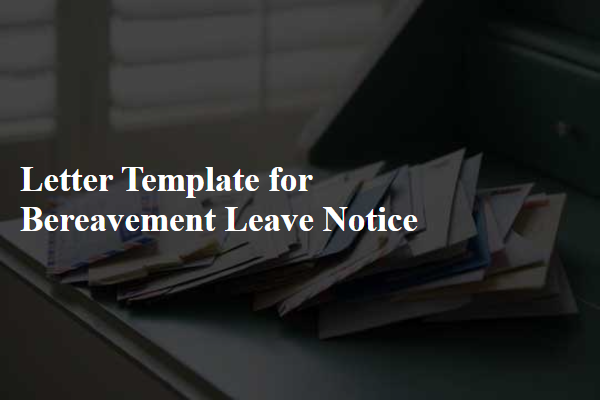When faced with the loss of a loved one, navigating the practicalities of work can feel overwhelming. That's why it's important to know how to write a compassionate and respectful bereavement leave notice. In this article, we'll guide you through creating a heartfelt letter that conveys your circumstances while maintaining professionalism. Join us as we discuss key elements to include in your notice to make the process a little easier during this difficult time.

Tone and language
In the wake of a family member's passing, employees often seek bereavement leave to navigate their grief and attend to necessary arrangements. It is essential to communicate with employers clearly and respectfully during this period. Employees should specify the relationship with the deceased and anticipated duration of leave. Following workplace policies and providing relevant documentation may be necessary to ensure a smooth process. Companies often express understanding, emphasizing the importance of offering support during this challenging time, facilitating a compassionate work environment.
Recipient details
A bereavement leave notice, typically submitted to a supervisor or HR department, conveys the unfortunate event of a death in the employee's family. The notice includes essential details such as the employee's name (for identification), the recipient's full name (to ensure clear communication), the company's name (to maintain professionalism), and relevant contact information (for follow-ups or queries). Dates of absence play a crucial role, indicating the expected start and end of the leave. Additionally, the relationship to the deceased, whether a parent, sibling, or spouse, provides context, and expressing appreciation for consideration showcases the employee's professionalism during a difficult time.
Purpose and duration
When a loved one passes away, emotional upheaval often accompanies the loss, necessitating a temporary absence from work for mourning and arrangements. During this difficult time, individuals may require bereavement leave, typically ranging from three to five days, depending on company policy and personal circumstances. This leave allows for essential tasks, such as attending the funeral, handling estate matters, and receiving support from family and friends. Employers usually expect a formal notice to address the situation, emphasizing respect for the privacy of the employee while informing them about the intended duration of leave.
Contact information
When requesting bereavement leave, it is crucial to provide clear details about the situation. State your full name, role in the organization, and contact information, including phone number and email address. Specify the relationship to the deceased, mentioning key details like the date of passing and any relevant dates for the leave request. This ensures the HR department understands the urgency and context of the situation. A mention of your expected return date can also aid in planning your absence. This structured approach conveys professionalism while respecting the sensitivity of the matter.
Appreciation and understanding
A bereavement leave notice is essential for communicating the need for time off during a difficult period. This notification should express appreciation for the support received from colleagues and management during this challenging time. Grieving individuals often encounter emotional distress, making it crucial for the workplace to foster an understanding atmosphere. Providing necessary details such as the relationship to the deceased, expected duration of absence, and proposed methods for managing work responsibilities can facilitate a smoother transition during the grieving process. Clear communication in such notices ensures the team remains informed while showing respect for the emotional needs of the grieving employee.
Letter Template For Bereavement Leave Notice Samples
Letter template of bereavement leave request for a family member's passing.

Letter template of bereavement leave application due to a close friend's death.

Letter template of bereavement leave notification for the loss of a parent.

Letter template of bereavement leave correspondence for the death of a spouse.

Letter template of bereavement leave formulating for a grandparent's funeral.

Letter template of bereavement leave submission for an immediate relative's loss.








Comments